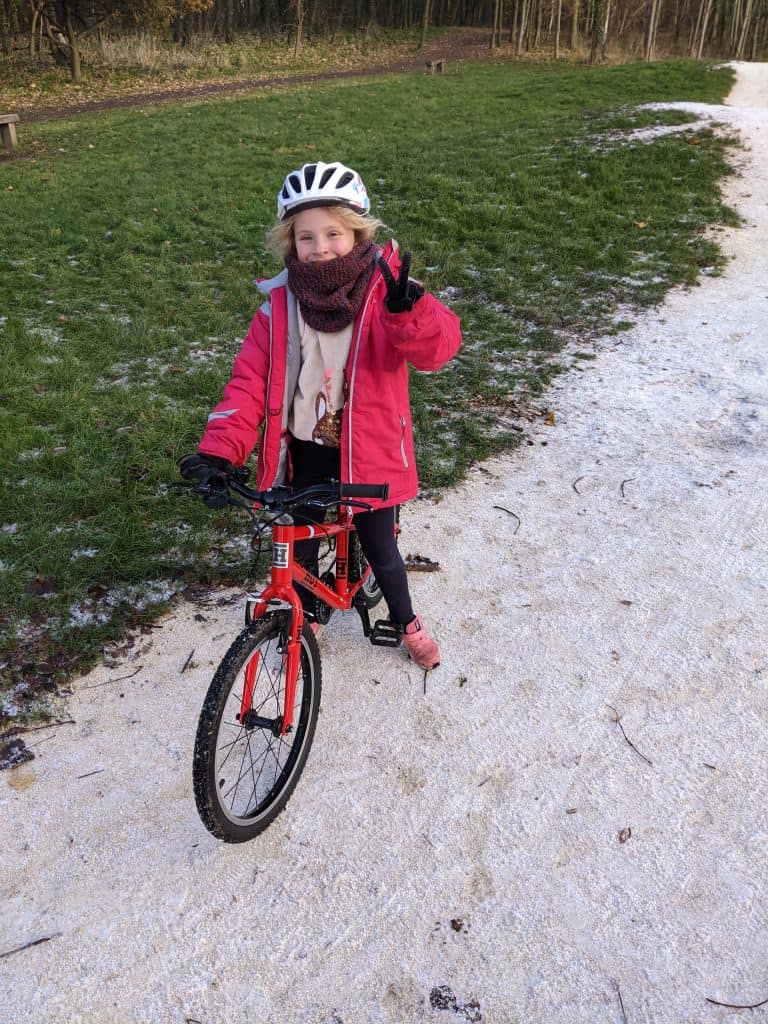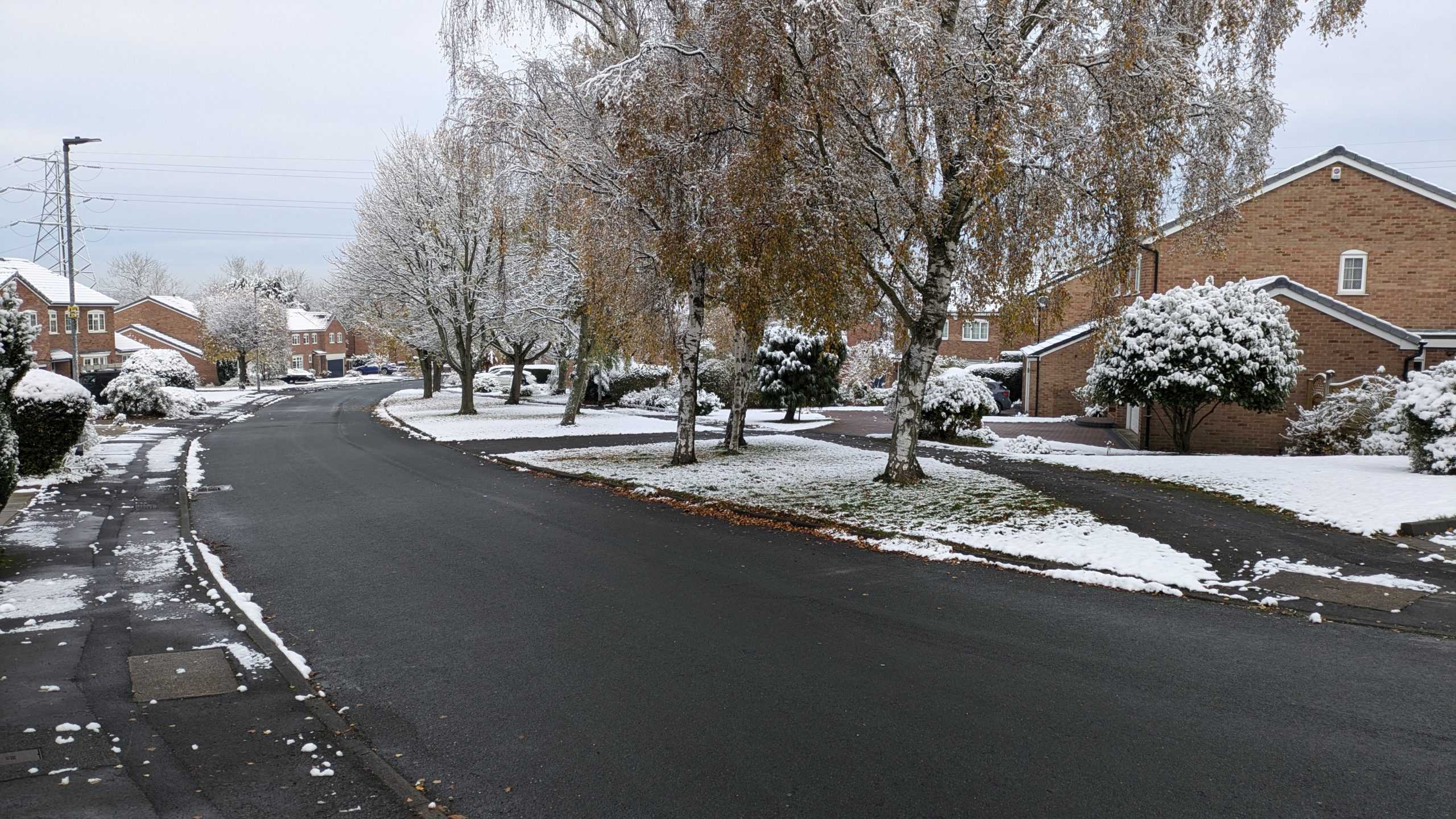The winter months are often when many families reluctantly trade in their walk/cycle to school habits for the warmth of the car. But for many reasons highlighted below it’s the best time to continue cycling.
Cycling to school has become a core part of our identity and our day-to-day life. Since our daughter Matilda started school in September 2020, we have cycled or walked to school every single day, without exception. We wouldn’t have it any other way. Our website is all about the joys of outdoor adventures with young children, and cycling is at the heart of our philosophy.
Today, we’re sharing why we continue to cycle to school even in winter and how you can make it work for your family too.
It’s worth noting that our advice is always aimed at those who have the means to do so. Many now work from home, close to home or work shifts. These can make the transition to cycling in all weather. We are here to promote positive habit changes in the day-to-day lives of ordinary families.
Why We Cycle to School in the Winter
Continuing the Habit
When the cold, dark mornings of winter set in, it can be tempting to trade in your bike for the convenience of the car. However, keeping up a routine is crucial.
Habits are powerful, and maintaining a consistent practice of cycling to school reinforces resilience for both parents and children. For us, cycling isn’t just about getting from A to B; it’s about establishing a lifestyle that emphasises movement, adventure, and sustainability. The temperature dropping is just part of the seasonality of where we live but it builds resilience and strength.
A Great Way for Children to Start the Day
Research has shown that starting the day with physical activity, like cycling, provides children with a mental boost that can improve focus and mood throughout the day. Exposure to fresh air first thing in the morning wakes up the senses and encourages a positive attitude, giving children a great head start before sitting in a classroom for several hours.
This cannot be replicated within a car journey which is a sedentary activity. The child will have limited exposure to the weather and will walk from the car to the comfort of the classroom.
It’s Quicker
Winter brings frosted windscreens and icy driveways, making driving a slower endeavour than you might think. By the time a driver has cleared the car of ice or snow, we’re already halfway to school on our bikes.
Our daily commute to school is just under a mile—an easy distance that we can cover quickly and comfortably by bike, even in cold weather. It’s common for us to see the traffic trailing back and slow-moving whereas on the bike we can navigate far quicker. Our particular commute involves off-road paths and alleyways meaning it’s logical to utilise the bike vs the car; even when it’s on the freezing side!


Mental Health Benefits
In winter, it can be easy to hunker down indoors and avoid physical activity. However, it’s arguably the most important time to stay active.
With shorter days and longer nights, getting exposure to natural light and fresh air is vital for both physical and mental health.
Cycling to school ensures that both parents and children start their day with a burst of movement, warming up their bodies and keeping their immune systems strong during the colder months.
Benefits for Both Parent and Child
Cycling together isn’t just about getting to school—it’s about spending quality time with our children. The conversations you have while cycling or walking are completely different to those you have when in a car. It’s a shared experience and you can comment on what you see and experience as you cycle.
It brings us closer together and helps build resilience in both the parent and the child.


How to Keep Warm While Cycling in Winter
Base Layers
The key to staying warm on winter rides is layering. Start with a good set of thermal base layers—both for yourself and your children. A snug base layer helps trap warmth close to the body without causing overheating.
You can buy these from most retailers. I recommend Merino Wool vs Synthetic. Ideally, the garment would have a higher level of Merino wool to synthetic ratio.
Gloves
Cold fingers can quickly turn a fun ride into a miserable one. Make sure everyone has a good pair of insulated gloves that allow for easy braking and steering.
Warm Footwear
Feet are often overlooked, but they’re one of the first body parts to get cold. Thick socks and waterproof shoes or boots are ideal for keeping little toes warm, even on frosty mornings.
This one can be altered depending on how far you cycle. For smaller journeys, you may be ok with normal footwear and thick socks (it can be a faff to change at school) but for longer ones, it may be a consideration.
Snoods and Head Warmers
One of our favourite winter cycling accessories is the snood—a versatile neck warmer that can be pulled up over the face when the wind picks up. I much prefer these to scarves as they are compact whereas a scarf is a little bulky. You can buy these for less than £5 and they do a great job of taking the chill from your neck/chin area.
A thermal hat or head warmer for the kids that fits under a helmet can make all the difference in keeping ears toasty during a ride.
Additional Tips for Winter Cycling with Kids
Take It Easy
Cycling in winter isn’t about speed—it’s about the journey. There’s no rush, so take your time and enjoy the ride. Go at a pace that feels comfortable for everyone, and don’t worry if it takes a few extra minutes to reach your destination.
It’s also worth noting that even cycling slowly is much faster than preparing a car to drive to school.
Lower Tyre Pressure
If the ground is icy or slippery, consider slightly lowering the pressure on your bike tyres.
This gives better traction and helps prevent skidding, making the ride safer for both you and your children. Just edge a little air out of the tyres and the bike will hold the road/path better.
Praise and Encouragement
Winter cycling can be challenging, especially for young children, so remember to praise your child for their effort. Highlight how brave and strong they are for cycling in cold weather, and make it fun by celebrating each ride.
Turning the experience into a positive one ensures that they look forward to the journey rather than dreading it.
Our personal experience is that once you have done it for a sustained period of time the habit is built and your child will not even question whether you are cycling or not. Our daughter wouldn’t want to commute in any other way but you have to build the habit first.
Summary:
For us, cycling to school in winter is a choice that goes beyond convenience or exercise—it’s about embracing a way of life that prioritises health, well-being, and connection.
Yes, it’s cold, and yes, it requires a bit more preparation but so does commuting by car; particularly when it’s snowing/icy. As long as you are organised, have the correct equipment and prepare the evening before it’s not much different to other modes of transport.
The moments spent cycling with our children are precious and the school run is a time we should cherish. As children get older they statistically spend less time with their parents.
If you’ve been thinking about cycling to school this winter, we encourage you to give it a try. Just because others aren’t doing so doesn’t mean you shouldn’t. Be an outlier, not a sheep.
With the right gear, a positive mindset, and a commitment to the habit, winter cycling can become a cherished part of your family’s routine. Not only will you be fostering a love for the outdoors in your children, but you’ll also be setting an example of perseverance and adventure—no matter the season.
Last Updated on January 29, 2025 by Ryan
Hello. I am Ryan and along with my wife Beth and our two children Matilda and Barney, we love all things cycling and exploring. We spend our weekends exploring fun places to cycle and discover and wanted to help other people do the same too. There’s no better way to travel than via bike and it’s an amazing activity for the whole family to enjoy.

